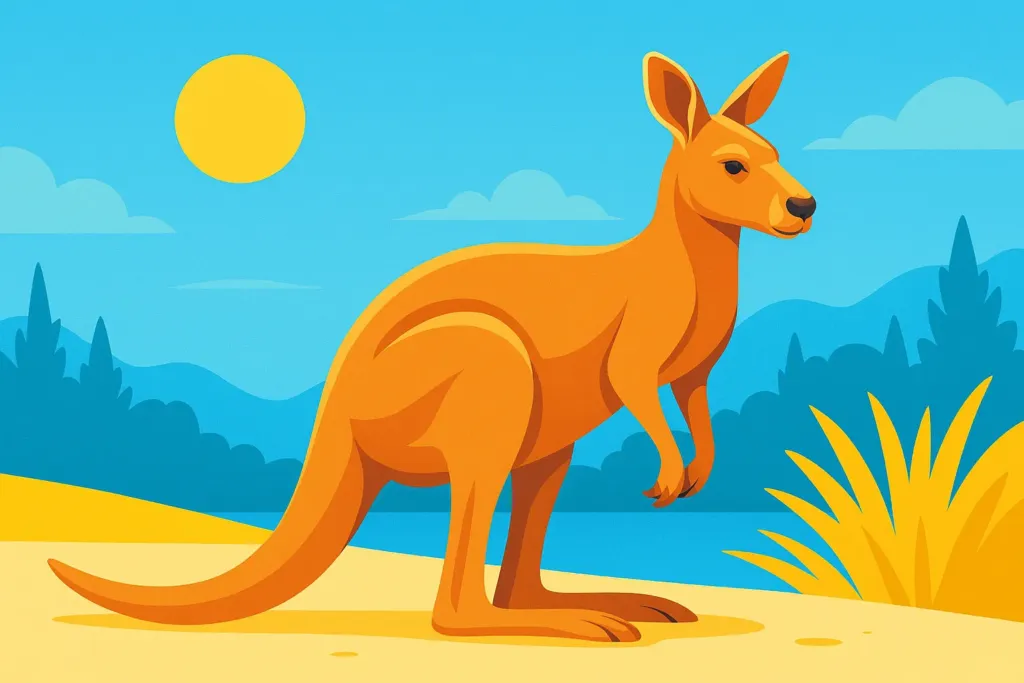Интересные факты
— Кенгуру — единственные крупные животные, передвигающиеся прыжками.
— Их мощные задние лапы и пружинистый хвост позволяют им развивать скорость до 55 км/ч и совершать прыжки длиной до 12 метров и высотой до 3 метров — словно человек прыгает через автобус.
— В Австралии численность кенгуру превышает численность населения: около 50 миллионов особей против примерно 26 миллионов жителей.
— Кенгуру не могут двигаться задом наперед из-за строения таза и хвоста.
— Их уши могут вращаться почти на 360 градусов, что помогает им улавливать звуки со всех сторон.
— Новорожденный детёныш имеет длину всего около 2,5 см — размером с виноградину — и продолжает развиваться в сумке матери около шести месяцев.
— Самка может одновременно вынашивать эмбрион, кормить детёныша в сумке и вскармливать более взрослого детёныша, используя молоко разного состава.
Происхождение названия
— Слово «кенгуру» пришло в английский язык из языка гуугу-йимитирр, одного из аборигенов Австралии, где «gangurru» обозначало большого серого кенгуру.
— Легенда о том, что это слово якобы означает «Я не понимаю» в ответ на вопросы европейцев, не подтверждена.
Численность и рекорды
— Самый крупный вид, рыжий кенгуру, может достигать 2 метров в высоту и веса более 90 кг.
— Рекордная длина прыжка составляет около 13,5 метров.
— Скорость на коротких дистанциях может достигать 70 км/ч, что сопоставимо с движением автомобиля в городе.
— Кенгуру могут преодолевать большие расстояния без значительных затрат энергии благодаря эластичности сухожилий задних ног, которые работают как пружины.
— В некоторых регионах Австралии плотность популяции кенгуру настолько высока, что ежегодно они становятся причиной десятков тысяч дорожно-транспортных происшествий.
Уникальность
— Кенгуру – эндемики Австралии и не встречаются в дикой природе на других континентах.
— Они играют важную роль в экосистеме, распространяя семена растений и поддерживая баланс лугов.
— Их способность экономить энергию при движении – уникальный биомеханический феномен, изучаемый инженерами для создания более эффективных транспортных средств и роботов.
Интересные случаи и истории
— Известны случаи, когда кенгуру спасали людей, предупреждали о пожарах или отпугивали хищников.
— В 2003 году кенгуру по кличке Лулу спасла фермера, потерявшего сознание, привлекая внимание его семьи.
— В то же время, бывают и трагические случаи: в засушливые годы кенгуру могут массово гибнуть от нехватки воды и пищи.
— Иногда они становятся жертвами лесных пожаров, площадь которых в Австралии может быть сопоставима с площадью целых европейских стран.
Катастрофы и гибель
— Помимо стихийных бедствий, кенгуру часто гибнут на дорогах.
— Столкновения с транспортными средствами — одна из основных причин их смертности.
— В засушливые годы массовая гибель от голода и жажды становится серьёзной экологической проблемой.
Туристические места
— Национальный парк Намаджи в Австралийской столичной территории — возможность увидеть кенгуру в дикой природе.
— Хребты Флиндерс в Южной Австралии — горные ландшафты и обилие кенгуру.
— Заповедник коал Лон-Пайн в Брисбене — тесное общение с кенгуру и их кормление.
— Остров Кенгуру в Южной Австралии — наблюдение за животными в их естественной среде обитания, пляжи и уникальная природа.
- Los Angeles
- How to Get Around Australia
- Mongolia
- Big Game Fishing — захватывающий туризм на волне приключений
- Brazil Travel Costs
- Brest (Belarus)
- Saami
- Mammoths and travel: where to see habitats, traces and digs, and museums
- Chechnya
- Africa
- Madagaskar
- Belarus
- Garden Route: живописная дорога вдоль океана
- Bosnia and Herzegovina
- Colombia
- Minsk (Belarus)
- Georgia
- Moab
- Decline in international tourism to the US: causes and consequences
- Scythians

 Singapore
Singapore